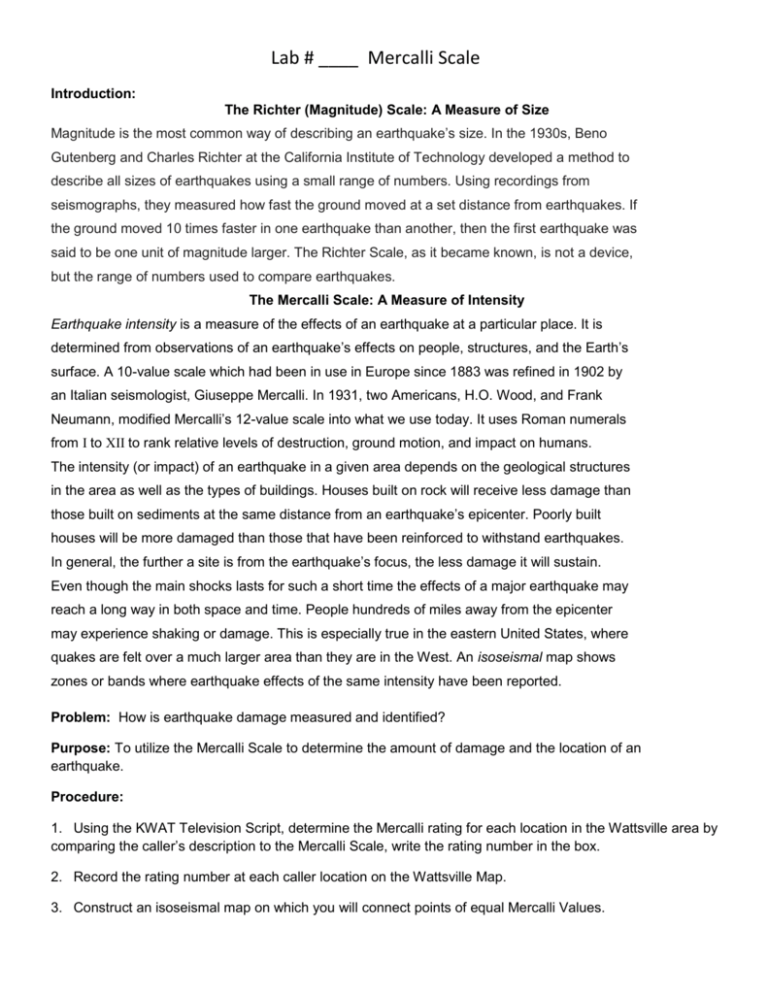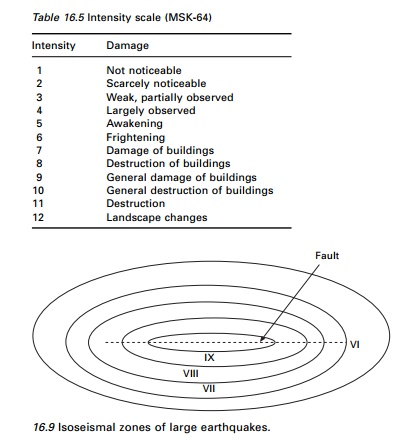A Refined Richter Scale Is Used to Describe Earthquake Magnitude
A scale used to measure earthquake magnitude is the __ scale. A Willmore seismometer measures earthquakes Earthquakes until recently have been measured on the Richter scale.

Lab Mercalli Scale Introduction The Richter Magnitude
The Richter magnitude scale was developed in 1935 by Charles F.

. However an earthquake can measure above 100 which is then called an epic earthquake. M L log 10 A log 10 A 0 δ where M L is the magnitude A is the maximum excursion or the greatest deviation on the Wood-Anderson seismograph and A 0 depends on the distance between the seismic station and epicenter δ. The Richter magnitude of an earthquake is determined from the logarithm of the amplitude of waves recorded by seismographs adjustments are included to compensate for the variation in the distance between the various seismographs and the epicenter of the earthquake.
Developed in 1935 by American seismologist Charles Richter the scale has been used to describe the amplitude of the largest single ground wave of earthquakes using a Wood-Anderson seismograph. Micro earthquakes are measured at between 1 and 19. The Richter scale is a numeric measure of the magnitude of an earthquake.
A refined richter scale is used to describe earthquake magnitude. The magnitude R is given by the equation. In this case the increase is in wave amplitude.
The Richter scale measures the. Scientists no longer rely on the the Richter scale to measure an earthquakes power. Heres how earthquakes are measured and why.
Richter Scale The most common and well known measurement method is known as the Richter scale United States Geological Survey 2015. Using the richter scale the __ of an earthquake is determined by measuring the amplitude of the largest wave recorded on the seismogram. - Developed by Charles F.
The Richter scale also called the Richter magnitude scale and Richters magnitude scale is a measure of the strength of earthquakes developed by Charles Francis Richter and presented in his landmark 1935 paper where he called it the magnitude scale. Seismologists use a Richter Magnitude scale to express the seismic energy released by an earthquake. S __ waves cannot pass through earths outer core.
Earthquakes vary widely from imperceptible to devastating strengths. Given below is a table that helps you understand the magnitude of an earthquake and the kind of damage it can cause to life and property. The appeal of the Richter magnitude scale is twofold.
Below is a look at each description. First an earthquake is summarized by an easy-to-remember and easy-to-interpret single-digit number. This magnitude scale was.
Richter both of whom were American seismologists in the year 1935 created it. R065log039E 145 where E is the energy measured in kilowatt-hours released by the earthquake. What is the Richter Scale.
The Richter Scale measures earthquakes by using seven different categories. What is the Richter Scale. The well known but not well understood Richter scale was developed by Charles Richter in 1935.
In 1935 Charles Richter developed the first magnitude scale to measure earthquakes. Richter Scale is mostly effective for regional earthquakes no greater than M5. BEGIN narrator The Richter Scale is a standard for measuring earth tremors.
This is calculated using information gathered by a seismograph. Micro minor light moderate strong major and great. Richter of the California Institute of Technology as a mathematical device to compare the size of earthquakes.
D The Richter and Moment Magnitude scales are used to describe the magnitude of an earthquake. Adjustments are included for the variation in the distance between the. Magnitude is a measure of the amount of energy released during an earthquake.
Beno Gutenberg and Charles F. It was invented in 1935 by Charles F. A magnitude 3 is a tiny earthquake.
The Richter scale is used to rate the magnitude of an earthquake that is the amount of energy released during an earthquake. The Richter scale is used to measure the magnitude of an earthquake. The magnitude of an earthquake is measured by determining the height of the biggest seismic wave shown on a scale by a.
The idea of a logarithmic earthquake magnitude scale was first developed by Charles Richter in the 1930s for measuring the size of earthquakes occurring in southern California using relatively high-frequency data from nearby seismograph stations. The chart below demonstrates Richter magnitude numbers and the explosive equivalent of energy that the magnitude represents. Seismic moment combines the seismic energy with offset on the fault and rigidity of rock.
The Richter scale is used to rate the magnitude of an earthquake -- the amount of energy it released. The Richter scale and the Mercalli scale are two basic ways of measuring earthquake magnitude in earth sciences. Richter Scale Measurements.
Now called the Richter scale it runs from 1 to 10 with 1 being the lowest magnitude quake and 10 being the. Earthquake size as measured by the Richter Scale is a well known but not well understood concept. Determine the amount of energy released by an earthquake of magnitude 75.
This was later revised and renamed the local magnitude scale denoted as ML or M L. The Richter Magnitude scale is a logarithmic scale representing the amplitudes of the seismograph reading. This magnitude scale was referred to as ML with the L standing for local.
Created by Charles F. Simply put it measures the amplitude height of wave of a waveform recorded on a seismograph. Since magnitude scales are logarithmic the size represented ramps very very quickly.
This magnitude would be considered a I on the Mercalli intensity scale. The original Richter scale formula that is used to calculate the magnitude of any earthquake is as follows. SIGNALERT has developed a system of intensity scales which are designed to allow a factual and unambiguous description of different impacts and effects generated by natural phenoma.
The Richter scale is logarithmic meaning that whole-number jumps indicate a tenfold increase. Both methods describe earthquake power from two different perspectives Harris 2001. Moment Magnitude is more effective for large earthquakes Moment Magnitude uses more variables to calculate the energy released using seismic moment.
Richter of the California Institute of Technology as a mathematical device to compare the size of earthquakes. It used a formula based on amplitude of the largest wave recorded on a specific type of seismometer and the distance between the earthquake and the seismometer. Each point higher represents an order of magnitude higher eg a 70 is 10x larger.
Because of the logarithmic basis of the scale each whole number increase in. The magnitude of an earthquake is determined from the logarithm of the amplitude of waves recorded by seismographs. The range of the Richter scale is between 0 and 10.

Earthquake Intensity And Magnitude

Richter Magnitude Scale Explained Cbc News Earthquake Earthquake Causes Earthquake Magnitude

Difference Between Sustainability Infographic Earthquake Magnitude Intense
0 Response to "A Refined Richter Scale Is Used to Describe Earthquake Magnitude"
Post a Comment